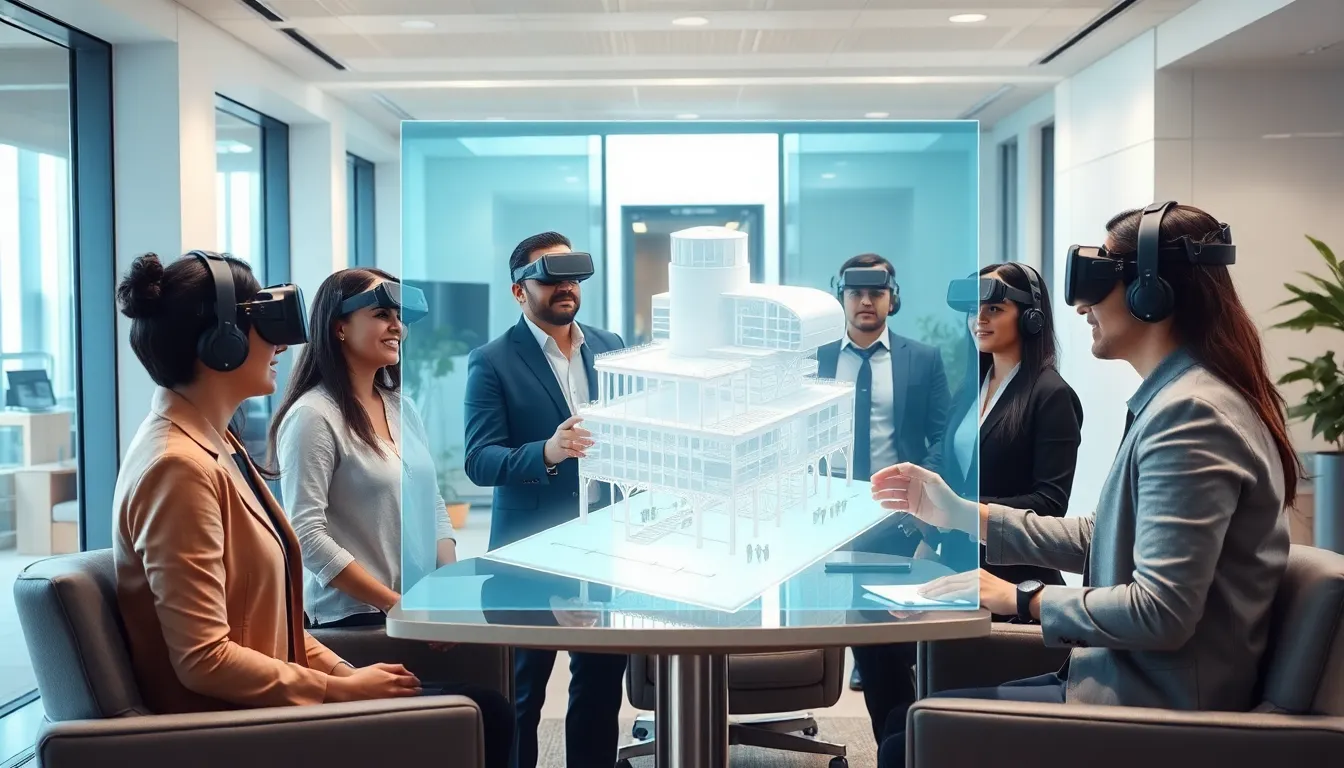In a world where technology is evolving at lightning speed, Augmented Reality (AR) is reshaping how projects are managed across various industries. By blending digital elements with the real world, AR enhances collaboration, visualization, and efficiency, making it an invaluable tool for project managers.
As teams navigate complex tasks and remote work challenges, AR project management offers innovative solutions that streamline processes and improve communication. This technology not only boosts productivity but also fosters creativity, allowing teams to visualize concepts in real-time. With AR’s growing influence, understanding its applications in project management is crucial for staying ahead in today’s competitive landscape.
Table of Contents
ToggleOverview of AR Project Management
AR project management incorporates augmented reality technology to enhance project workflows and improve team collaboration. This innovative approach transforms how teams visualize and execute project tasks, significantly impacting efficiency and effectiveness.
Definition of AR Project Management
AR project management refers to using augmented reality tools and applications to facilitate planning, execution, and monitoring of projects. It allows project managers and teams to overlay digital information onto physical environments, enabling a more interactive and immersive experience. This technology assists in visualizing data, simulations, and models in real-time, which aids decision-making processes and mitigates potential issues early on.
Importance in Today’s Projects
AR technology plays a crucial role in modern projects by enhancing collaboration among team members.
- Seamless communication: Teams can share insights instantly through AR platforms, thus reducing miscommunication and fostering clear understanding.
- Real-time feedback: Project stakeholders receive immediate visual feedback on project progress, allowing for quicker adjustments and optimization.
- Enhanced visualization: Complex data becomes easier to interpret when visualized through AR, allowing teams to grasp intricate concepts without extensive explanations.
- Remote capabilities: AR enables remote collaboration, allowing team members from different locations to engage actively as if they are in the same physical space.
Incorporating AR into project management not only streamlines processes but also cultivates innovative solutions that drive project success.
Key Features of AR Project Management

AR project management incorporates advanced features that enhance productivity and collaboration. These features facilitate improved efficiency in planning and executing projects.
Real-Time Collaboration
Real-time collaboration tools leverage AR technology to promote teamwork. Teams can share virtual spaces, allowing members to interact with digital models and data simultaneously, regardless of location. This real-time engagement fosters immediate problem-solving and decision-making. Features include live updates, instant feedback loops, and the ability to annotate visuals, enabling all team members to stay aligned and informed.
Enhanced Visualization Techniques
Enhanced visualization techniques utilize AR to transform how teams perceive project data. By superimposing digital information onto physical environments, teams can better understand complex structures and systems. For instance, 3D models can be viewed at scale on-site, providing a clear perspective on potential challenges. Visualization tools also allow for interactive simulations, aiding in project forecasting and risk assessment. These techniques streamline communication by enabling stakeholders to visualize concepts, resulting in more informed discussions and faster approvals.
Tools and Technologies for AR Project Management
AR project management utilizes various tools and technologies to maximize its effectiveness in enhancing project workflows. These tools cater to different aspects of project management, from planning to execution.
Popular AR Software
Numerous software solutions facilitate AR project management, improving collaboration and visualization. Key examples include:
- Unity: Offers a powerful platform for creating AR applications with robust development capabilities.
- Vuforia: Provides a comprehensive framework for creating AR experiences, prominently used in industrial applications.
- Hololens: A mixed-reality headset that allows for immersive AR collaboration, integration of 3D models, and real-time interaction.
- Blipper: Focuses on creating AR content for marketing and educational purposes through an accessible interface.
- ZapWorks: This platform enables users to design, develop, and publish AR experiences without extensive coding knowledge.
Integration with Existing Project Management Tools
AR tools integrate seamlessly with traditional project management software, enhancing functionality. Key integrations include:
- Trello: AR overlays on Trello boards promote visual task tracking and team collaboration.
- Asana: Interactive AR elements in Asana streamline task assignments and updates.
- Microsoft Teams: Integration with AR enhances communication through shared virtual workspaces, facilitating real-time collaboration on projects.
- Slack: AR features can be added to Slack for visual updates and enhanced team interaction during discussions.
These integrations elevate project management efficiency by combining the strengths of established platforms with augmented reality capabilities, fostering a cohesive workflow.
Benefits of Implementing AR in Project Management
Implementing Augmented Reality (AR) in project management yields numerous benefits, enhancing team interactions and optimizing processes. The integration of AR technology not only elevates communication methods but also significantly boosts overall efficiency.
Improved Communication
AR promotes enhanced communication among project teams. Through virtual overlays of project data, team members can visualize issues and solutions, ensuring everyone operates from a unified understanding. Real-time feedback and discussions occur in an interactive environment, reducing misinterpretations. Additionally, AR tools enable remote teams to collaborate as if they were in the same location, bridging geographical gaps efficiently. This immediacy fosters stronger relationships and a culture of transparency, vital for successful project outcomes.
Increased Efficiency
AR technology directly contributes to increased efficiency in project management. By visualizing complex data instantly, project teams can identify potential challenges or bottlenecks early, allowing for proactive solutions. Engaging with digital models in a three-dimensional space enables quicker decision-making and validation of concepts before physical implementation. Furthermore, augmented interactions streamline workflows, reduce the need for time-consuming revisions, and accelerate the approval process. Through these capabilities, AR not only enhances productivity but also cultivates an environment conducive to innovation.
Challenges in AR Project Management
AR project management faces several challenges that can impede its effectiveness. From technical limitations to user adoption issues, understanding these obstacles is crucial for successful implementation.
Technical Limitations
Technical limitations hinder the seamless integration of AR in project management. Factors affecting performance include:
- Device Compatibility: Different AR applications operate on various devices, leading to compatibility issues and potential disruptions in workflow.
- Connectivity Requirements: AR tools often require stable internet connections, limiting functionality in areas with poor coverage.
- Hardware Constraints: High-performance hardware is necessary for robust AR experiences, which can be cost-prohibitive for some organizations.
- Software Development: Creating custom AR applications may require specialized skills and resources, posing a barrier for teams lacking technical expertise.
These technical constraints can affect the fluidity of project execution and reduce the anticipated benefits of AR technology.
User Adoption Issues
User adoption issues pose significant challenges in the successful implementation of AR project management. Key concerns include:
- Training Requirements: Employees often need substantial training to effectively utilize AR tools, which can disrupt productivity during the learning phase.
- Resistance to Change: Team members may resist adopting new technologies due to a lack of familiarity, resulting in underutilization of AR capabilities.
- Perceived Complexity: Some users may perceive AR as overly complex, leading to frustration and decreased engagement with the technology.
- Digital Divide: Variances in technical proficiency among team members can create disparities in AR usage, affecting overall project collaboration.
Addressing these adoption-related challenges is essential to fully leverage the advantages of AR in project management.
Future Trends in AR Project Management
AR project management continues to evolve with advancements in technology. This section explores emerging technologies and predictions that will shape its future.
Emerging Technologies
5G technology enhances AR project management by enabling fast data transfer and low latency. This capability supports real-time updates and seamless collaboration in remote work environments. Artificial Intelligence (AI) integrates with AR tools to offer intelligent insights and automate routine tasks, improving decision-making processes. Additionally, the Internet of Things (IoT) connects AR applications to smart devices, providing enriched contextual information and facilitating enhanced project monitoring.
Advanced AR hardware, including lighter, more ergonomic headsets, continues to emerge, improving user experience and accessibility. These developments promote wider adoption across diverse industries by increasing comfort during prolonged use. Furthermore, mixed reality environments are becoming more prevalent, blending physical and virtual elements to facilitate immersive collaboration and planning.
Predictions for Growth
The AR project management market is projected to grow significantly. According to industry sources, the market value might reach $198 billion by 2025, driven by increasing demand for remote collaboration tools. Industries such as construction, healthcare, and education are likely to lead in AR adoption, leveraging its capabilities for training, visualizing complex designs, and enhancing patient care.
The integration of AR with existing project management software will also expand. Users can expect streamlined workflows as AR tools become standard in programs such as Microsoft Teams and Trello. Enhanced user experiences will likely include intuitive interfaces and personalized features, making AR technology more accessible to teams with varying technical skills. The rise of collaborative platforms coupled with AR functionalities will redefine team interactions and boost productivity.
AR project management is reshaping how teams approach complex tasks and remote collaboration. By merging digital information with the physical world, it enhances communication and visualization, driving efficiency and creativity. As industries increasingly adopt AR tools, the potential for improved project outcomes becomes evident.
While challenges remain in terms of technical integration and user adoption, the future looks promising. Emerging technologies and advancements in AR are set to revolutionize project management even further. Embracing these innovations will not only streamline workflows but also foster stronger team dynamics, ultimately leading to greater success in project execution.


